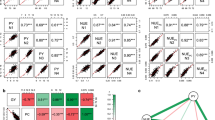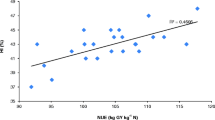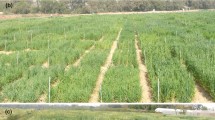Abstract
Background and aims
The modern wheat cultivars have been selected for non-limiting nitrogen (N) input situations and therefore require large amounts of fertiliser N. The relatively high price of fossil fuels increases the cost of N fertilisers, putting pressure on wheat farmers. Doubled-haploid mapping populations can lead to identification of specific loci that might be useful in marker-assisted breeding for increased N-use efficiency.
Methods
Forty-one mostly Australian genotypes of wheat (Triticum aestivum L.) (parents of existing doubled-haploid mapping populations) were grown to maturity in soil in a glasshouse. Two N treatments were tested: optimal (685 mg N pot−1) and low (171 mg N pot−1).
Results
Plant growth was significantly lower in most genotypes (with the exception of Mendos and Gamenya) at low compared with optimal N supply. Leaf-6 extension rate in the low-N treatment was on average 76 % of that in the optimal N treatment. Grain yield was significantly affected by the treatment x genotype interaction, ranging from 2.5 (genotype WAWHT2046) to 7.0 g per plant (genotype Mendos) under low N supply, and from 3.8 (genotype Wilgoyne) to 10.1 g per plant (genotype Lang) under optimal N supply. Based on responses to differential N supply, Mendos and Wilgoyne ranked as N-use efficient. In contrast, ten genotypes (Cadoux, Frame, Gamenya, Halberd, Janz, Lang, Neepawa, Spear, Sunco and Tasman) were ranked as N-use inefficient. The old genotype Gamenya was relatively N-use efficient, but had a poor response to N fertilisation. Amery and Janz responded similarly to Gamenya.
Conclusions
Even though genotypes used in the current study were bred mostly for yield, a range of differential responses to the low- and optimal-N treatments implies that efficient use of N at low supply and efficient response to N fertilisation might have been inadvertently selected for in some breeding programmes, suggesting a potential for breeding wheat cultivars with improved N-use efficiency.







Similar content being viewed by others
References
Anderson WK, Hoyle FC (1999) Nitrogen efficiency of wheat cultivars in a Mediterranean environment. Aus J Exp Agric 39:957–965
Arnall DB, Mallarino AP, Ruark MD, Varvel GE, Solie JB, Stone ML, Mullock JL, Taylor RK, Raun WR (2013) Relationship between grain crop yield potential and nitrogen response. Agron J 105:1335–1344
Aulakh MS, Rennie DA, Paul EA (1982) Gaseous nitrogen losses from cropped and summer-fallowed soils. Can J Soil Sci 62:187–196
Austin RB, Ford MA, Edrich JA, Blackwell RD (1977) The nitrogen economy of winter wheat. J Agric Sci 88:159–167
Bänziger M, Betrán FJ, Lafitte HR (1997) Efficiency of high-nitrogen selection environments for improving maize for low-nitrogen target environments. Crop Sci 37:1103–1109
Barbottin A, Lecomte C, Bouchard C, Jeuffroy M-H (2005) Nitrogen remobilization during grain filling in wheat. Crop Sci 45:1141–1150
Baric M, Sarcevic H, Keresa S, Habus Jercic I, Rukavina I (2007) Genotypic differences for nitrogen use efficiency in winter wheat (Triticum aestivum L.). Cereal Res Commun 35:213–216
Barraclough PB, Howarth JR, Jones J, Lopez-Bellido R, Parmar S, Shepherd CE, Hawkesford MJ (2010) Nitrogen efficiency of wheat: genotypic and environmental variation and prospects for improvement. Eur J Agron 33:1–11
Bertholdsson N-O, Stoy V (1995) Accumulation of biomass and nitrogen during plant growth in highly diverging genotypes of winter wheat. J Agron Crop Sci 175:167–182. doi:10.1111/j.1439-037X.1995.tb00208.x
Blevins DW, Wilkison DH, Kelly BP, Silva SR (1996) Movement of nitrate fertiliser to glacial till and runoff from a claypan soil. J Environ Qual 25:584
Bock BR (1984) Efficient use of nitrogen in cropping systems. In: Hauck RD (ed) Nitrogen in crop production. Madison, WI, USA, pp. 273–294
Brancourt-Hulmel M, Doussinault G, Lecomte C, Bérard P, Le Buanec B, Trottet M (2003) Genetic improvement of agronomic traits of winter wheat cultivars released in France from 1946 to 1992. Crop Sci 43:37
Cassman KG, Dobermann A, Walters DT, Yang H (2003) Meeting cereal demand while protecting natural resources and improving environmental quality. Ann Rev Env Resour 28:315–358
Chichester FW, Richardson CW (1992) Sediment and nutrient loss from clay soils as affected by tillage. J Environ Qual 21:587–590
Cooper M, Woodruff DR, Phillips IG, Basford KE, Gilmour AR (2001) Genotype by management interactions for grain yield and grain protein concentration of wheat. Field Crops Res 69:47–67. doi:10.1016/S0378-4290(00)00131-3
Cox MC, Qualset CO, Rains DW (1985) Genetic variation for nitrogen assimilation and translocation in wheat. II. Nitrogen assimilation in relation to grain yield and protein. Crop Sci 25:435–440
Damon PM, Ma QF, Rengel Z (2011) Wheat genotypes differ in potassium accumulation and osmotic adjustment under drought stress. Crop Pasture Sci 62:550–555
Dawson JC, Huggins DR, Jones SS (2008) Characterizing nitrogen use efficiency in natural and agricultural ecosystems to improve the performance of cereal crops in low-input and organic agricultural systems. Field Crops Res 107:89–101
Derkx AP, Orford S, Griffiths S, Foulkes MJ, Hawkesford MJ (2012) Identification of differentially senescing mutants of wheat and impacts on yield, biomass and nitrogen partitioning. J Integr Plant Biol 54:555–566
Dong B, Rengel Z, Graham RD (1995) Root morphology of wheat genotypes differing in zinc efficiency. J Plant Nutr 18:2761–2773
Dupont FM, Altenbach SB (2003) Molecular and biochemical impacts of environmental factors on wheat grain development and protein synthesis. J Cereal Sci 38:133–146
Evans LT (1998) Greater crop production: whence and whither? In: Waterlow J, Armstrong D, Fowden L, Riley RH (eds) Feeding a world population of more than eight billion people. Oxford University Press, Oxford, pp. 89–97
FAO (Food and Agriculture Organization) (2014) Food and agriculture organisation of the United Nations, Rome, http://faostat.fao.org
Feller U, Fischer A (1994) Nitrogen metabolism in senescing leaves. Crit Rev Plant Sci 13:241–273
Ferrante A, Savin R, Slafer GA (2013) Floret development and grain setting differences between modern durum wheats under contrasting nitrogen availability. J Exp Bot 64:169–184
Foulkes MJ, Hawkesford MJ, Barraclough PB, Holdsworth MJ, Kerr S, Kightley S, Shewry PR (2009) Identifying traits to improve the nitrogen economy of wheat: recent advances and future prospects. Field Crops Res 114:329–342. doi:10.1016/j.fcr.2009.09.005
Gaju O, Allard V, Martre P, Snape JW, Heumez E, LeGouis J, Moreau D, Bogard M, Griffiths S, Orford S, Hubbart S, Foulkes MJ (2011) Identification of traits to improve the nitrogen-use efficiency of wheat genotypes. Field Crops Res 123:139–152. doi:10.1016/j.fcr.2011.05.010
Guarda G, Padovan S, Delogu G (2004) Grain yield, nitrogen-use efficiency and baking quality of old and modern Italian bread-wheat cultivars grown at different nitrogen levels. Eur J Agron 21:181–192
Habash DZ, Bernard S, Schondelmaier J, Weyen J, Quarrie SA (2006) The genetics of nitrogen use in hexaploid wheat: N utilisation, development and yield. Theor Appl Genet 114:403–419
Harper LA, Sharpe RR, Langdale GW, Giddens JE (1987) Nitrogen cycling in a wheat crop: soil, plant, and aerial nitrogen transport. Agron J 79:965
Jiang Z, Sullivan WM, Hull RJ (2000) Nitrate uptake and nitrogen use efficiency by Kentucky bluegrass cultivars. Hortscience 35:1350–1354
Jones DB (1941) Factors for converting percentages of nitrogen in foods and feeds into percentages of proteins. Circular No. 183. US Department of Agriculture Washington, DC
Kichey T, Hirel B, Heumez E, Dubois F, Le Gouis J (2007) In winter wheat (Triticum aestivum L.), post-anthesis nitrogen uptake and remobilisation to the grain correlates with agronomic traits and nitrogen physiological markers. Field Crops Res 102:22–32
Ladha JK, Pathak H, Krupnik TJ, Six J, van Kessel C (2005) Efficiency of fertilizer nitrogen in cereal production. Adv Agron 87:85–156
Le Gouis J, Béghin D, Heumez E, Pluchard P (2000) Genetic differences for nitrogen uptake and nitrogen utilisation efficiencies in winter wheat. Eur J Agron 12:163–173. doi:10.1016/S1161-0301(00)00045-9
Liao M, Fillery IRP, Palta JA (2004) Early vigorous growth is a major factor influencing nitrogen uptake in wheat. Funct Plant Biol 31:121–129
Liao M, Palta JA, Fillery IRP (2006) Root characteristics of vigorous wheat improve early nitrogen uptake. Aust J Agric Res 57:1097–1107
Malik AI, Rengel Z (2013) Physiology of nitrogen-use efficiency. In: Rengel Z (ed) Improving water and nutrient-use efficiency in food production systems. Wiley-Blackwell Inc, UK, pp. 105–121
Masclaux C, Valadier M-H, Brugière N, Morot-Gaudry J-F, Hirel B (2000) Characterization of the sink/source transition in tobacco (Nicotiana tabacum L.) shoots in relation to nitrogen management and leaf senescence. Planta 211:510–518
McNeal FH, Berg MA, Watson CA (1966) Nitrogen and dry matter in five spring wheat varieties at successive stages of development. Agron J 58:605
Mitchell R a C, Mitchell VJ, Driscoll SP, Franklin J, Lawlor DW (1993) Effects of increased CO2 concentration and temperature on growth and yield of winter wheat at two levels of nitrogen application. Plant Cell Environ 16:521–529
Moll RH, Kamprath EJ, Jackson WA (1982) Analysis and interpretation of factors which contribute to efficiency of nitrogen utilization. Agron J 74:562
Möller K, Stinner W (2009) Effects of different manuring systems with and without biogas digestion on soil mineral nitrogen content and on gaseous nitrogen losses (ammonia, nitrous oxides). Eur J Agron 30:1–16
Ortiz-Monasterio RJI, Sayre KD, Rajaram S, McMahon M (1997) Genetic progress in wheat yield and nitrogen use efficiency under four nitrogen rates. Crop Sci 37:898–904. doi:10.2135/cropsci1997.0011183X003700030033x
Osborne LD, Rengel Z (2002) Screening cereals for genotypic variation in efficiency of phosphorus uptake and utilisation. Aust J Agric Res 53:295–303
Otteson BN, Mergoum M, Ransom JK (2007) Seeding rate and nitrogen management effects on spring wheat yield and yield components. Agron J 99:1615–1621. doi:10.2134/agronj2007.0002
Palta JA, Fillery IRP (1995a) N application enhances remobilization and reduces losses of pre-anthesis N in wheat grown on a duplex soil. Crop Pasture Sci 46:519–531
Palta JA, Fillery IRP (1995b) N application increases pre-anthesis contribution of dry matter to grain yield in wheat grown on a duplex soil. Aust J Agric Res 46:507–518
Pang J, Palta JA, Rebetzke GJ, Milroy SP (2014) Wheat genotypes with high early vigour accumulate more nitrogen and have higher photosynthetic nitrogen use efficiency during early growth. Func Plant Biol 41:215–222
Raun WR, Solie JB, Johnson GV, Stone ML, Mullen RW, Freeman KW, Thomason WE, Lukina EV (2002) Improving nitrogen use efficiency in cereal grain production with optical sensing and variable rate application. Agron J 94:815–820
Raun WR, Solie JB, Stone ML (2011) Independence of yield potential and crop nitrogen response. Precision Agric 12:508–518
Rebetzke GJ, Condon AG, Farquhar GD, Appels R, Richards RA (2008) Quantitative trait loci for carbon isotope discrimination are repeatable across environments and wheat mapping populations. Theor Appl Genetics 118:123–137
Rengel Z, Graham RD (1995) Wheat genotypes differ in Zn efficiency when grown in chelate-buffered nutrient solution. Plant Soil 176:307–316
Schwenke GD, Manning W, Haigh BM (2014) Ammonia volatilisation from nitrogen fertilisers surface-applied to bare fallows, wheat crops and perennial-grass-based pastures on Vertosols. Soil Res 52:805–821
Sebilo M, Mayer B, Nicolardot B, Pinay G, Mariotti A (2013) Long-term fate of nitrate fertiliser in agricultural soils. Proc Nat Acad Sci USA 110:18185–18189
Siddique KHM, Belford RK, Tennant D (1990) Root:shoot ratios of old and modern, tall and semi-dwarf wheats in a Mediterranean environment. Plant Soil 121:89–98. doi:10.1007/BF00013101
Stagnari F, Onofri A, Codianni P, Pisante M (2013) Durum wheat varieties in N-deficient environments and organic farming: a comparison of yield, quality and stability performances. Plant Breed 132:266–275
Tester M, Langridge P (2010) Breeding technologies to increase crop production in a changing world. Science 327:818–822
Tilman D, Cassman KG, Matson PA, Naylor R, Polasky S (2002) Agricultural sustainability and intensive production practices. Nature 418:671–677
Van Sanford DA, MacKown CT (1986) Variation in nitrogen use efficiency among soft red winter wheat genotypes. Theor Appl Genetics 72:158–163
Van Sanford DA, MacKown CT (1987) Cultivar differences in nitrogen remobilization during grain fill in soft red winter wheat. Crop Sci 27:295
White PJ, George TS, Gregory PJ, Bengoug AG, Hallett PD, McKenzie BM (2013) Matching roots to their environment. Ann Bot 112:207–222
Acknowledgments
Financial support for this work was provided by the Grains Research and Development Corporation, Canberra. SV gratefully acknowledges Hungarian National Eötvös Fellowship programme.
Author information
Authors and Affiliations
Corresponding author
Additional information
Responsible Editor: Philip John White .
Rights and permissions
About this article
Cite this article
Malik, A.I., Veres, S. & Rengel, Z. Differential nitrogen-use efficiency in wheat parents of doubled-haploid mapping populations. Plant Soil 408, 311–325 (2016). https://doi.org/10.1007/s11104-016-2943-9
Received:
Accepted:
Published:
Issue Date:
DOI: https://doi.org/10.1007/s11104-016-2943-9




